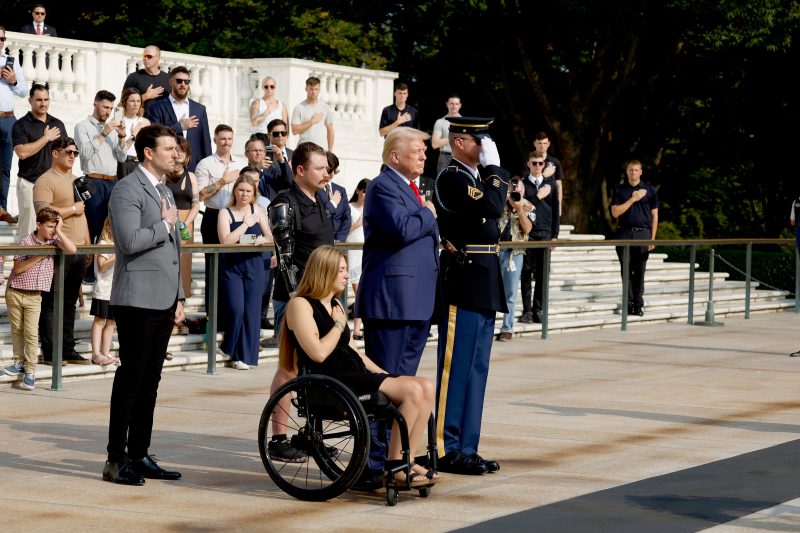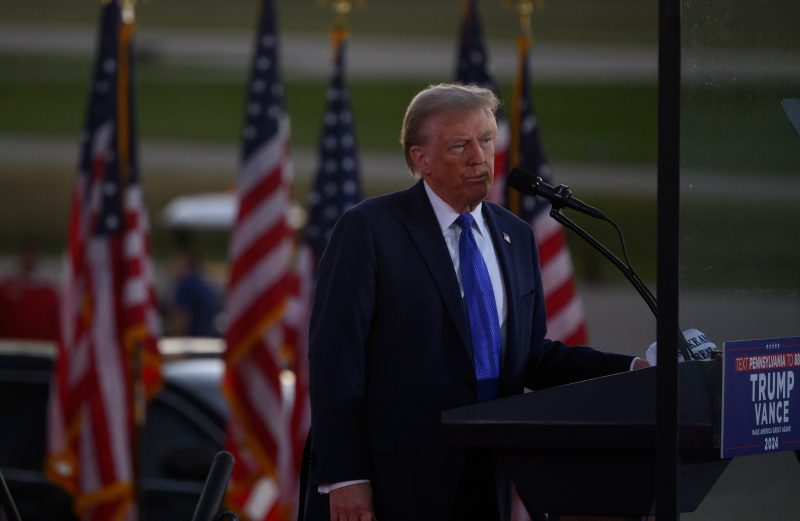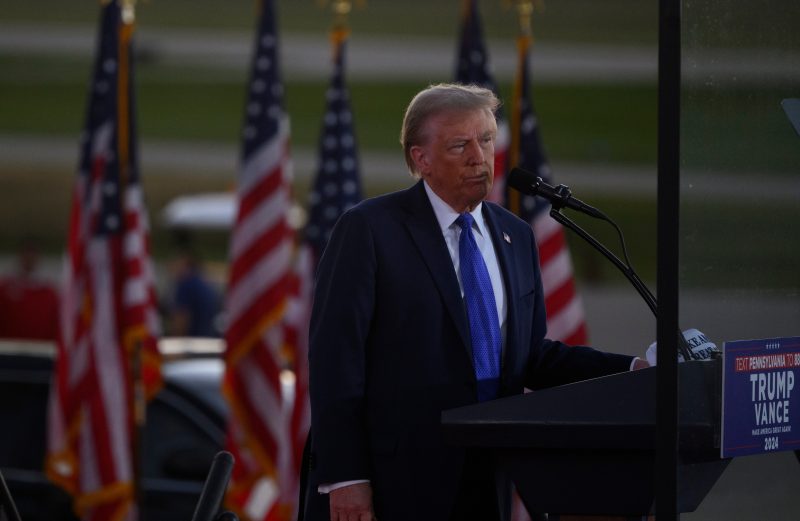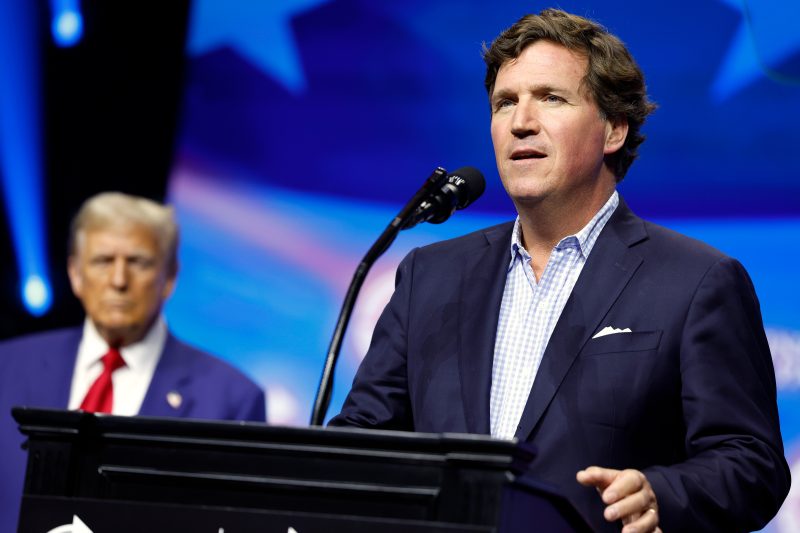
How a Trump visit sparked turmoil at America’s most sacred cemetery
Earlier this month, Republican presidential nominee Donald Trump’s campaign contacted military officials about visiting Arlington National Cemetery to mark the third anniversary of the Islamic State bombing that killed 13 U.S. service members during the evacuation from Afghanistan.
Federal law prohibits election-related activities at military cemeteries, and Arlington is the most prestigious and sacred of all. Pentagon officials were deeply concerned about the former president turning the visit into a campaign stop, but they also didn’t want to block him from coming, according to Defense Department officials and internal messages reviewed by The Washington Post.
Officials said they wanted to respect the wishes of grieving family members who wanted Trump there, but at the same time were wary of Trump’s record of politicizing the military. So they laid out ground rules they hoped would wall off politics from the final resting place of those who paid the ultimate sacrifice for their nation.
Instead, they got sucked into exactly the kind of crisis they were hoping to avoid.
A cemetery employee tried to enforce the rules as provided to her by blocking Trump’s team from bringing cameras to the graves of U.S. service members killed in recent years, according to a senior defense official and another person briefed on the incident. A larger male campaign aide insisted the camera was allowed and pushed past the cemetery employee, leaving her shocked.
Trump campaign spokesman Steven Cheung responded to the first report of the altercation, from NPR on Tuesday, by accusing, without evidence, the employee of “suffering from a mental health episode.” Defense officials said that the employee was trying to do her job and that the claim of a mental health episode was false. On Wednesday Cheung said the employee “initiated physical contact that was unwarranted and unnecessary.”
Cheung also said the campaign would release footage to support his claim but has not. The campaign did, however, post a TikTok of the event on Wednesday — exactly what military officials tried to prevent. The use of the footage marked a flagrant violation of the law against partisan actions at military cemeteries, defense officials said.
The visit comes as Trump struggles to regain his footing in a race altered by Vice President Kamala Harris’s replacement of President Joe Biden on the Democratic ticket. He often portrays himself as a champion of the military, but Democrats point to his public and private remarks denigrating service members.
“I just haven’t seen anything this disgusting,” said Paul Eaton, a retired Army general and adviser to the liberal group VoteVets whose father’s remains are interred at Arlington. “It is completely inappropriate to do any kind of political activity on a federal installation, and it is immoral in my terms to conduct any kind of self-serving activity on a cemetery with the graves of our fallen.”
Defense officials were concerned about the event Monday because Republicans have frequently used the bombing, a low point of the Biden administration, as a political cudgel. In advance of the event, cemetery officials told Trump’s team that he could come in his personal capacity and bring personal aides, but not campaign staff. Campaign advisers went anyway.
No hats, signs or banners were allowed, according to military officials. No speeches. Reporters and photographers could follow Trump for a ceremony at the Tomb of the Unknowns, but not to the 14-acre plot where veterans from recent wars are buried, known as Section 60. The media was kept away, unable to see the altercation — or anything else, for that matter — during that part of his visit.
The first part went according to plan. With full media coverage, Trump and two Marines injured in the bombing, Tyler Vargas-Andrews and Kelsee Lainhart, laid a wreath at the tomb, a monument dedicated to deceased U.S. troops whose remains have not been identified or recovered. The press then returned to a holding area, specifically instructed that reporters and cameras would not accompany Trump and bereaved families to Section 60.
But Trump officials said they did not view the campaign’s own photographer and videographer as subject to the same restrictions, so they continued on to Section 60. Their arrival there prompted the standoff with the cemetery employee over the rules. The identity of the Trump aide involved was not known Wednesday.
The incident has raised concerns about the safety of Arlington staff members, the senior defense official said, with vitriol aimed at them initially on Monday by liberals, after the news coverage of Trump at the cemetery was published. That has given way to language from conservatives that also is “concerning.”
“If the campaign feels the need to defend their team’s actions — which include bullying and physically pushing out of the way a longtime public servant and member of the team at Arlington working to protect the sanctity of the sacred spaces — then that’s on them,” one defense official said. “The rules were made clear to participants, and these two chose to disregard those rules. End of story.”
A brief report of the incident was filed with security personnel overseeing the cemetery, the senior defense official said. The confrontation is not under investigation by either the Army Criminal Investigation Division or the Naval Criminal Investigative Service, officials with each organization said.
Co-campaign manager Chris LaCivita, who was present Monday along with other campaign employees, in a statement called the cemetery employee “a despicable individual” who “does not deserve to represent the hollowed grounds of Arlington National Cemetery.” LaCivita posted video on X on Monday of Trump laying flowers at the grave of Staff Sgt. Ryan Knauss, a soldier killed in the explosion, and speaking to his family on the phone.
In addition to the campaign’s TikTok video, Trump posed for photos on Monday at the graveside of Marine Sgt. Nicole Gee with her family, including one where he is giving a thumbs-up gesture and others are smiling. Eaton called the gesture “appalling.”
The campaign also defended itself with a joint statement from the two injured Marines who appeared with Trump and thefamilies of some of the service members killed, saying theywanted Trump and his cameras there.
Darin Hoover, whose son, Staff Sgt. Darin “Taylor” Hoover, died in the bombing, reaffirmed that in an interview Wednesday.
“We invited him. He didn’t come to us,” Hoover said. “He has shown nothing but sincerity to all of us and for what happened to our children, and for anybody else to try to take that away from the ceremony — both at the wreath-laying and at the graveside — is unconscionable.”
Hoover and some of the other grieving families also participated in the Republican National Convention and said Biden has not granted multiple requests to meet with him. They have grown closer to Trump over the years after bad interactions with Biden, who has offended some Gold Star families by discussing the death of his son Beau, who died of brain cancer after returning from serving in Iraq, in a meeting with them.
Other veterans and bereaved families viewed Trump’s visit as disrespectful to a sacred space that also belongs to them and to the nation. Section 60 is a place where young widows can be seem trimming grass with hand scissors, sharing comfort with other Gold Star families, and decorating graves with flowers and beads. Visitors have long taken graveside photographs there, and sitting presidents have visited before, but not as part of campaign events.
“That’s not the time or place for it,” said Karen Meredith, a VoteVets board member whose son, 1st Lt. Ken Ballard, is buried in the second row of Section 60. “They had to bully themselves into this thing. The lack of respect for the rules or the norms or the laws at Arlington — there’s just no respect.”
Rep. Michael Waltz (R.-Fla.), an Army veteran who participated in the Arlington event on Monday, stood by the family’s wishes and accused the cemetery employee of overstepping.
“If they had a Trump-Vance banner and campaign signs, or if he went to the microphone and hit the other side, then okay,” he said. “But that wasn’t the case.”
Trump’s running mate, Sen. JD Vance (R-Ohio), turned the incident into a political attack during a campaign speech in Erie, Pa., on Wednesday. “We’re going to talk about a story out of those 13 brave, innocent Americans who lost their lives,” he said. He then falsely accused Harris of criticizing Trump’s visit to the cemetery, which she hasn’t commented on. A Harris campaign spokesman called it “pretty sad.”
“She wants to yell at Donald Trump because he showed up,” Vance said. “She can go to hell.”
Trump has repeatedly defied restrictions on using federal property for campaign purposes by staging a political speech at Mount Rushmore, participating in a television interview inside the Lincoln Memorial, and holding the 2020 Republican National Convention at the White House itself. As president, he pushed unsuccessfully for a European-style military parade down Pennsylvania Avenue.
At the same time, Trump has repeatedly badmouthed the sacrifices of American service members. In 2015, he mocked the late Sen. John McCain (R-Ariz.) for his time as a prisoner of war (“I like people who weren’t captured”), and earlier this month said the civilian Presidential Medal of Freedom was “much better” than the military Medal of Honor because those who received the latter were “either in very bad shape because they’ve been hit so many times by bullets, or they’re dead.”
Trump’s former aides have said he similarly disparaged service members in private, which he denies. Retired Gen. Mark A. Milley, a former chairman of the Joint Chiefs of Staff, said Trump responded to appearing with a wounded veteran by saying, “No one wants to see that.” His former chief of staff, John Kelly, said Trump called U.S. Marines buried at cemeteries in France “suckers” and “losers.” (Other former aides have said they didn’t hear those remarks.) Kelly has also said Trump told him during a previous visit to Section 60 at Arlington National Cemetery, “I don’t get it. What was in it for them?”
“He never understood why would you do anything that doesn’t benefit you,” one former senior Trump White House official said, speaking on the condition of anonymity to describe a private interaction. “I remember talking to him about death and sacrifice for the country, and it was like talking Greek to him. That’s why it’s the height of hypocrisy he’s there laying a wreath, given his general feelings about veterans.”
The former official said it was painful to see the suffering families put their faith in Trump.
“They are clearly grieving, and their kids have given the ultimate sacrifice, and they think he can help them,” the former official said. “They don’t know who he really is and what he’s really about. It’s not their fault.”
Cheung called the former official a “coward” for speaking anonymously.
Hau Chu, Alex Horton, Hannah Knowles, Amy B Wang and Marianne LeVine contributed to this report.



